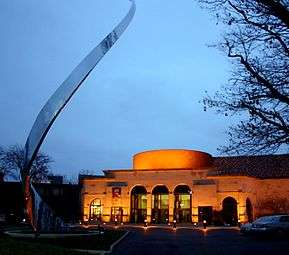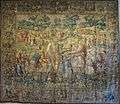Dayton Art Institute
The Dayton Art Institute (DAI) is a museum of fine arts in Dayton, Ohio, United States. The Dayton Art Institute has been rated one of the top 10 best art museums in the United States for children.[2] The museum also ranks in the top 3% of all art museums in North America in 3 of 4 factors.[3] In 2007, the art institute saw 303,834 visitors.[4]
Dayton Art Institute | |
 | |
  | |
| Location | Forest and Riverview Aves., Dayton, Ohio |
|---|---|
| Coordinates | 39°45′57″N 84°12′4″W |
| Area | 6 acres (2.4 ha) |
| Built | 1930 |
| Architect | Edward B. Green |
| Architectural style | Renaissance, Italian Renaissance Revival |
| NRHP reference No. | 74001579 [1] |
| Added to NRHP | November 19, 1974 |
History
Founded in a downtown mansion in 1919 as the Dayton Museum of Fine Arts, the museum moved to a newly designed Edward B. Green building in 1930. The DAI was modeled after the Casino in the gardens of the Villa Farnese at Caprarola, and the front hillside stairway after the Italian Renaissance garden stairs at the Villa d'Este, near Rome, and Italy. It is also visible from and easily accessible from I-75, which passes through the center of Dayton.[5]
The museum was later renamed the Dayton Art Institute as an indication of the growing importance of its school in addition to the museum. The nearly 60,000-square-foot (5,600 m2) building is now listed on the National Register of Historic Places.
Museum information
The museum's collection contains more than 20,000 objects spanning 5,000 years. In September, 2005, the Museum became one of eleven galleries in the US to host The Quest for Immortality: Treasures of Ancient Egypt, the largest collection of ancient artifacts ever to travel outside Egypt.
The art museum is an Italian Renaissance–style building, which sits atop a hill overlooking downtown Dayton. The Institute's highlights are the museum's Asian, 17th-century Baroque, 18th- and 19th-century American, and contemporary art collections. In addition to its collections, the museum frequently features other exhibitions.[6]
Notable works
Some of the most notable works held by the Institute are:[7][8]
- The Song of the Nightingale by William-Adolphe Bouguereau
- Purple Leaves[9] by Georgia O'Keeffe
- Cantata by Norman Lewis
- Untitled[10] by Joan Mitchell
- Sea Change[11] by Helen Frankenthaler
- Untitled[12] by Louise Nevelson
- Louise Nevelson[13] by Alison Van Pelt
- Lost and Found[14] by Alison Saar
- Embroidery from Uzbekistan[15] by Janet Fish
- Sawdy[16] by Edward Kienholz
- Study Heads of an Old Man by Peter Paul Rubens
- High Noon by Edward Hopper
- Aurora Red Ikebana with Bright Yellow Stems by Dale Chihuly
- After the Bath by Edgar Degas
- Stacks in Celebration by Charles Sheeler
- Scene in Yosemite Valley by Albert Bierstadt
- Allegory of the Four Seasons by Bartolomeo Manfredi
- Water Lilies by Claude Monet
- American Indian Series (Russell Means) by Andy Warhol
- Homage to Painting by Roy Lichtenstein
- Shimmering Madness by Sandy Skoglund [17]
Gallery
- The Song of the Nightingale by William-Adolphe Bouguereau
 Allegory of the Four Seasons by Bartolomeo Manfredi
Allegory of the Four Seasons by Bartolomeo Manfredi
References
- "National Register Information System". National Register of Historic Places. National Park Service. March 13, 2009.
- "Best Art Museum for Kids". Retrieved 2009-04-01.
- "Top art museum". Archived from the original on February 1, 2009. Retrieved 2009-07-29.
- "Attendance fact sheet" (PDF). Archived from the original (PDF) on 2012-03-13. Retrieved 2010-04-14.
- "Dayton art museum history". Archived from the original on 2003-10-09. Retrieved 2009-05-26.
- "Dayton art museum information". Retrieved 2009-05-26.
- "Notable Works". Archived from the original on 2011-05-13. Retrieved 2009-06-24.
- "Notable Works 2". Archived from the original on 2009-10-15. Retrieved 2009-06-24.
- "Purple Leaves | Dayton Art Institute". www.daytonartinstitute.org. Retrieved 2017-10-07.
- "Untitled | Dayton Art Institute". www.daytonartinstitute.org. Retrieved 2017-10-07.
- "Sea Change | Dayton Art Institute". www.daytonartinstitute.org. Retrieved 2017-10-07.
- "Untitled | Dayton Art Institute". www.daytonartinstitute.org. Retrieved 2017-10-07.
- "Alison Van Pelt: The Women | Dayton Art Institute". www.daytonartinstitute.org. Retrieved 2017-10-07.
- "Lost and Found | Dayton Art Institute". www.daytonartinstitute.org. Retrieved 2017-10-07.
- "Embroidery From Uzbekistan | Dayton Art Institute". www.daytonartinstitute.org. Retrieved 2017-10-07.
- "Sawdy | Dayton Art Institute". www.daytonartinstitute.org. Retrieved 2017-10-07.
- "Shimmering Madness | Dayton Art Institute". www.daytonartinstitute.org. Retrieved 2020-04-09.